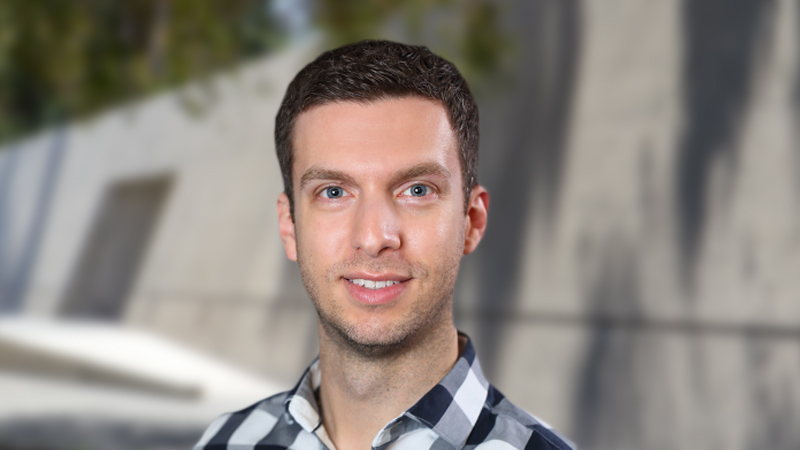Running a successful lab is not just about coming up with the best scientific ideas. It’s also about working to eliminate barriers and empowering trainees to fulfill their potential. Since joining Scripps Research as an assistant professor in the Department of Immunology and Microbiology in 2020, Michael Constantinides, PhD has established multiple programs to engage students from underrepresented communities in STEM and to increase representation of marginalized groups at the faculty level.

What is your research focus?
Every surface of the body harbors distinct communities of commensal microbes, known as microbiota, that promote the immune system and other bodily functions. In turn, the immune system modulates the composition of these microorganisms and segregates them by sustaining barrier tissue function. This dialogue between the microbiota and the host is of particular importance for specialized immune cells called innate lymphocytes, which predominantly localize in barrier tissues and have been increasingly recognized for their diverse roles in physiology.
My lab studies how microbes influence the development and function of innate lymphocytes and the mechanism by which these immune cells reciprocally regulate the microbiota. We are developing targeted approaches to modulate these interactions and generating innovative therapies for the treatment of infectious diseases, autoimmunity and cancer.
How do you approach mentorship in your role as an assistant professor?
My extensive mentoring experience has taught me the importance of inclusivity, and I strive to engage trainees as much as possible. I ask students questions throughout my lectures, which encourages them to apply their knowledge and reinforces their understanding of key concepts. As co-organizer of my department’s Research In Progress seminar series, I initiated anonymous feedback forms which allow all audience members to share their opinions and provide honest evaluations for the presenters. I’ve also instituted a policy of soliciting questions from trainees before faculty, which I’ve extended to all seminars that I host.
Within my laboratory, I adapt my mentorship to each trainee’s abilities, striking a balance between providing sufficient guidance to ensure they succeed while allowing their creativity to thrive. All trainees are encouraged to ask questions during our biweekly lab meetings, and on alternating weeks, I hold hour-long meetings with each lab member to discuss results, plan experiments and resolve concerns. I also maintain an open-door policy so I’m available to celebrate exciting results and address pressing issues immediately. Each trainee drafts an individual development plan which we discuss annually to ensure their training prepares them for their career goals, and I have quarterly lunches with trainees to learn about their non-academic interests. We also organize regular lab events to promote camaraderie, which have included barbecues, potlucks, beach days, an annual lab retreat and a celebration on the lab’s anniversary.
What made you want to work for Scripps Research?
Scripps Research has a plethora of resources and a collegial environment which make groundbreaking scientific discoveries possible. The institute’s organization facilitates interdisciplinary research and its proximity to UC San Diego, the Salk Institute, and the La Jolla Institute for Immunology, as well as multiple hospitals, enables both academic and clinical collaborations. The top 10 ranked graduate program attracts exceptionally capable students and prepares them to succeed. These attributes make Scripps Research an ideal institution to establish a laboratory.
What does Diversity, Equity, Inclusion, Accessibility and Belonging mean to you?
Diverse perspectives and experiences enrich our institutions and further academic research. However, inequality results in the exclusion of individuals who could otherwise make important contributions. The fraction of STEM bachelor’s degrees awarded to underrepresented racial and ethnic groups is ~50% below their proportion of the U.S. population, and their representation among STEM faculty is an additional ~50% lower. To increase the representation of these groups in bachelor’s programs and faculty positions, I initiated and continue to organize the following programs at Scripps Research:
The REsearch Awareness for Community High schools (REACH) program fosters interest in biomedical research among public high school students from economically disadvantaged neighborhoods (where more than 50% of students are eligible for free meals). The program has an “outREACH” component that involves Scripps Research scientists visiting students for career talks. This year more than two dozen faculty, graduate students and postdoctoral fellows visited five high schools, with presentations held in classrooms with around 30 students and auditoriums filled with more than 250.The program also has an “in REACH” component, where high school students are provided transportation to Scripps Research for Science Saturday, and take part in lab tours, hands-on demonstrations and poster presentations. Students are also invited to participate in laboratory research through a seven-week paid summer internship, which pairs them with graduate student mentors who teach experimental design and techniques, and data interpretation.
I am looking to expand our outREACH visits to eight public high schools next year, so please contact me if you’re aware of eligible schools that would like to participate!
The Future Leaders of Immunology Symposium is an annual event for highly accomplished postdoctoral fellows from underrepresented groups in science, including women, racial and ethnic minorities, and immigrants. This platform amplifies the exposure of participants prior to applying for faculty positions and offers presentation practice in advance of interviews. Last year’s presentations were broadcast via Zoom to 116 registrants, and I anticipate greater participation this year.